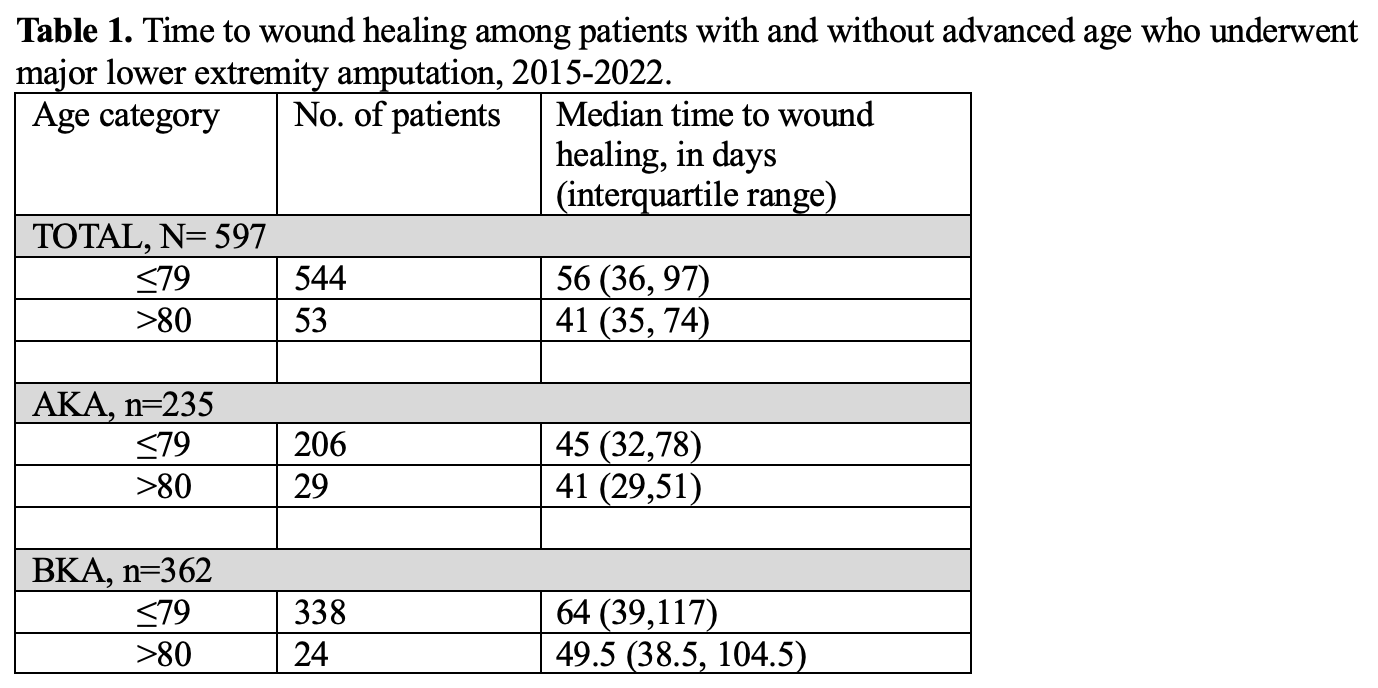Wound Healing in Older Adults After Major Lower Extremity Amputation
Maja Wichhart Donzo1, Nathaniel Forrester1, Chengcheng Hu2, Brandi M. Mize3, Yazan Duwayri3, Camille P. Vaughan4, Olamide Alabi3
1Emory University School of Medicine, Atlanta, GA;2Department of Surgery, Emory University School of Medicine, Atlanta, GA;3Division of Vascular Surgery and Endovascular Therapy, Department of Surgery, Emory University School of Medicine, Atlanta, GA;4Division of Geriatrics & Gerontology, Department of Medicine, Emory University School of Medicine, Atlanta, GA
BACKGROUND: The higher prevalence of multiple chronic conditions and frailty among older adults may increase the physiologic demand required for wound healing after a major lower extremity amputation (LEA). Compared to an above knee amputation (AKA), patients after below knee amputations (BKA) generally have improved prosthetic fitting rates, postoperative ambulation, and quality of life, however, the benefit of a BKA must be weighed against the risk of wound complications. The purpose of this study is to examine the association between advanced age and wound healing in our contemporary cohort of patients who underwent LEA. METHODS: Our study reviewed all patients who received LEA at two major academic healthcare systems between 1/2015 and 12/2022. Patients with prior ipsilateral LEA were excluded. The exposure of interest was advanced age, defined as age over 80 years old, and the primary outcome was time to wound healing (defined as clinical documentation of a healed amputation incision). Chi-squared test was used to evaluate advanced age and prosthetic fitting after LEA and Cox proportional hazard models were fit to examine the relationship between advanced age and time to wound healing after a LEA. RESULTS: Among 597 patients who underwent LEA, 8.9% (n=53) were over the age of 80. Over one-third of all patients underwent AKA (n= 235, 39.4%) and patients with advanced age represented 12.3% of this group. There was no statistically significant difference detected between the proportion of those with advanced age who were fit for prosthetic compared to those under age 79 who were fit for prosthetic (47.1% vs 58.5%, p=0.11). The median time to wound healing was faster among those with advanced age, even when stratified by level of LEA (Table 1). Advanced age was associated with faster wound healing (hazard ratio [HR] 1.42; 95% CI, 1.06-1.87). CONCLUSIONS: In our cohort of patients, those with advanced age healed faster than their younger counterparts at both levels of LEA and are equally likely to receive a prosthetic after LEA. Age alone should not be used as a factor in determining eligibility to undergo LEA or receipt of prosthetic. Future studies will evaluate other clinical characteristics that are associated with successful wound healing among adults 80 and older.

Back to 2024 Posters


